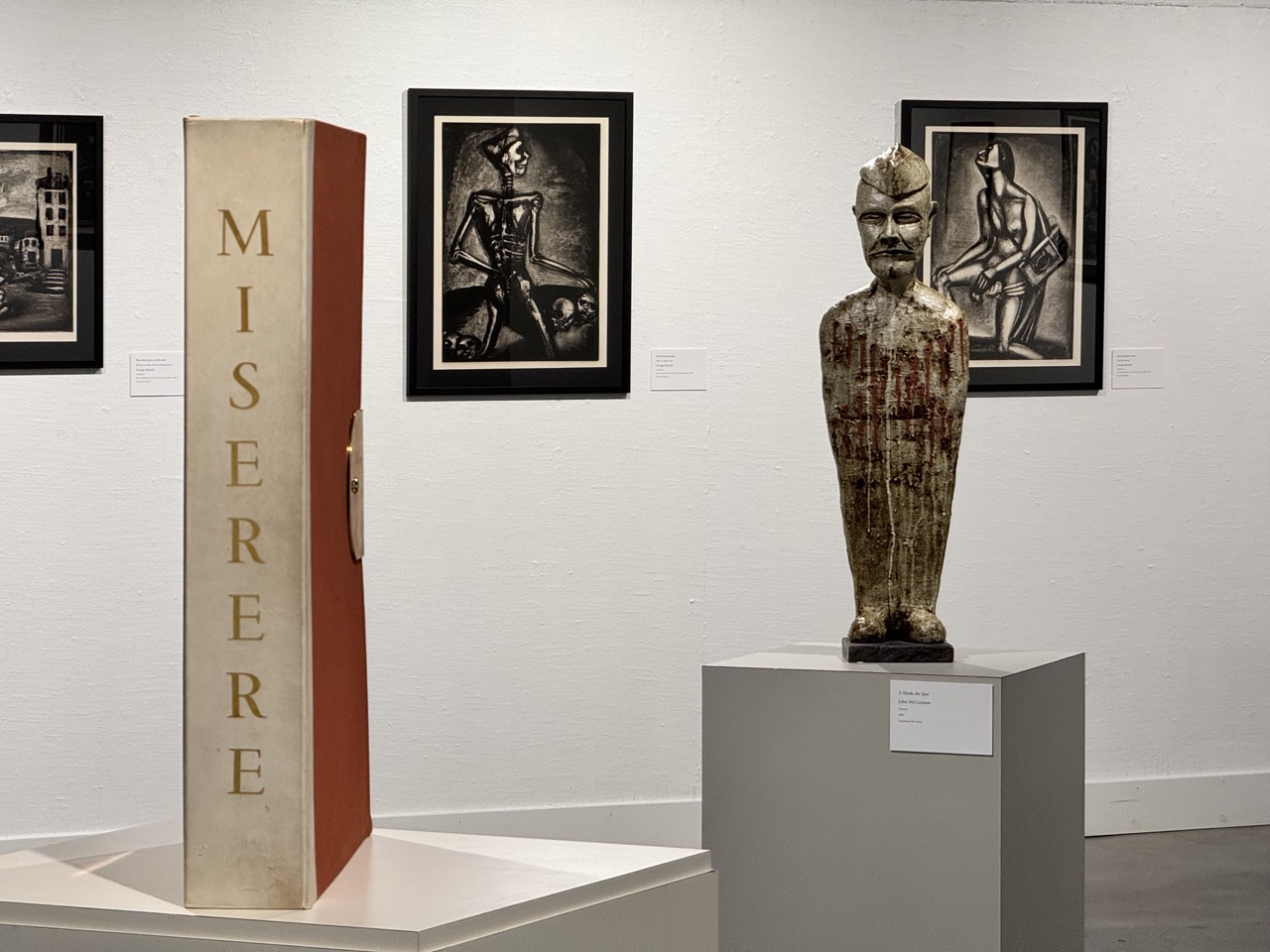Confronting Perpetual War: Kittredge Gallery’s Venture into War and How We Deal With It

By Max Orr
How do we reconcile with the horrors of perpetual war? How do we confront the realities of wars past and present? How do they affect us today? The new exhibit currently on display in Kittredge Gallery attempts to answer these questions with a series of prints entitled “Miserere,” created between 1914 and 1948 by artist Georges Rouault. The works, created over the span of two world wars, explore the human cost of modern warfare and the artist’s reconciliation with this reality through his faith. The gallery puts Rouault’s prints into conversation with pieces from the University’s permanent collection, featuring works by Professor Emeritus of CeramicsJohn McCuistion and Professor of Printmaking Janet Marcavage. These pieces were created around the time of the Iraq War, connecting historical wars to those of the recent past.
I recently had the privilege of touring the exhibit with the co-curators, Professor of Art History Kelsey Eldridge and Gallery Manager Peter Stanley. As we walk through the gallery, I am struck by the themes of the selections. The show takes on a strong Christian overtone. For Rouault, who converted to Catholicism following the death of his mentor, faith was irrevocably linked to his experience with the war. “Christianity was something he came to later in life, and it became a way for him to like work through everything that was going on after World War One. And he saw this, like the Passion of the Christ, as linked to the kind of redeeming humanity for the sins of war,” said Eldridge, who joined the project at the request of Stanley due to her expertise in religious artwork. Many of the works chosen to accompany the Rouault prints also carry this theme of Christ’s sacrifice. Stanley mentions this as we are stopped in front of a 16th-century print by Albrecht Dürer.“We rarely do religious artwork shows, you know religious artwork has this long history, including even in our collection. So we have pieces that are overtly Christian, and they don’t usually see the light of day,” he said. Many works that have never had the opportunity to be shown in a Kittredge Gallery are on display now, demonstrating the breadth of the University’s collection.
The show is split into three sections. The first explores the human cost of war, both to soldiers and those who are displaced. Here, Rouault’s connection to his faith is frequently visible, especially in his prints depicting the Passion of the Christ. As the visitor moves into the second room, the show shifts to confront the artist’s interpretations of who the villains of war are. For Rouault, they are the bourgeoisie: the people who profit from conflict. Also featured is a ceramic portrait of former Vice President Dick Cheney, depicted in devil form by McCuistion, a choice that can help contemporary viewers relate to the images of Rouault’s time. The final section features a motif that may be unfamiliar to many visitors: the Veronica. The Veronica tells the story of a woman present at the crucifixion of Jesus, who wiped his face with a cloth, producing an outline of his likeness. The image became an icon and a popular motif in medieval German art. Its representation in Rouault’s work is curious, but again points to his spirituality and its influence on his work. Eldridge and Stanley have also taken this portion of the show to discuss the art of printmaking. “It’s kind of like a meta-reference to printmaking, and Rouault, you could sort of think of him as comparing himself maybe to the Veronica,” he said. The section also includes work by Professor of Ceramics Janet Marcavage.
The University received the “Miserere” prints in 2019 as a gift from alumnus and donor Paul Gingrich (‘49). They comprise 316 of the original set of 425 prints made in 1948. When they came into the collection, the prints were damaged from years of poor storage conditions. Thanks to a monetary donation also made by Gingrich, Stanley was able to begin the process of restoration on some of the prints. They were treated by a method called light bleaching, which uses sun and a buffer solution to remove stains and lighten pages that may have darkened over time.
When discussing some of the challenges they faced in putting the exhibit together, Eldridge and Stanley both expressed concern for getting a primarily young audience interested in Rouault’s work. Eldridge stated, “Having to like, navigate the content of the series, while keeping in mind the interests of the campus in the community, was definitely our challenge.” This show attempts to answer questions about how we navigate the world we live in. It shows how Rouault chose to answer those questions and invites us to think about them for ourselves.
“War and Passion: Selections from Georges Rouault’s ‘Miserere’ in Context” will be on view until Oct. 19, with a reception in Kittredge Gallery on Oct. 9 at 5 p.m.
